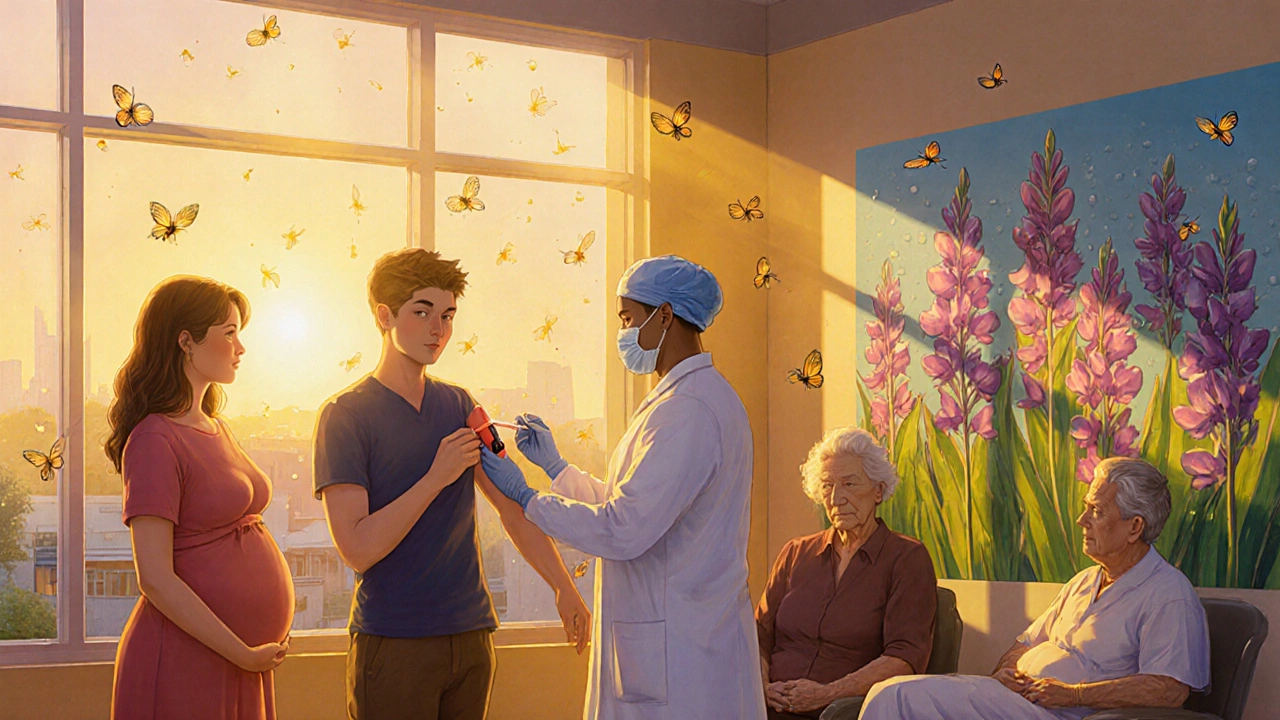For centuries, syphilis was a silent killer. People didn’t know how it spread, how to treat it, or even how to tell if someone had it. In the 1500s, a person with a rash or sore might be accused of sin, banished from town, or left to die. By the 1900s, doctors were still using crude, painful, and often useless methods just to confirm if someone carried the disease. Today, a simple blood test can detect syphilis in minutes. But how did we get from guesswork and torture to reliable, accurate testing? The story isn’t just about science-it’s about fear, ethics, and the slow, painful march of medical truth.
When Syphilis Was a Mystery
Syphilis erupted across Europe in the late 1400s, right after Columbus returned from the Americas. No one knew where it came from. Some blamed the stars. Others blamed sin. The disease showed up as painful sores, then rashes, then madness and death. Without a name, without a cause, and without a test, doctors had no way to confirm it.
They relied on symptoms alone. A skin lesion? Maybe syphilis. A fever and swollen glands? Could be anything. A patient went blind or lost their mind decades later? Probably syphilis, but no one could say for sure. There was no lab, no microscope powerful enough to see the bacterium Treponema pallidum. Diagnosis was a guess wrapped in superstition.
The First Real Test: The Wassermann Test
In 1906, German scientist August von Wassermann changed everything. He discovered that syphilis triggered a specific reaction in blood. His test, the Wassermann test, was the first reliable way to detect syphilis without waiting for symptoms to destroy a person’s body.
The test worked by mixing a patient’s blood with a substance made from beef heart tissue. If syphilis was present, the blood clumped. It wasn’t perfect-false positives were common, especially in people with malaria or lupus. But for the first time, doctors had proof. Hospitals started using it. Public health programs adopted it. By the 1920s, it was standard in maternity wards.
But here’s the dark side: the test became a tool of control. In the U.S., Black women, immigrants, and poor women were forced to take it without consent. In Nazi Germany, it was used to justify sterilization. The science was real-but the ethics? Not so much.
The Tuskegee Experiment and the Cost of Silence
In 1932, the U.S. Public Health Service started a study in Tuskegee, Alabama. They wanted to see what happened when syphilis went untreated. So they recruited 600 Black men-399 with syphilis, 201 without. They told them they had "bad blood." They gave them useless treatments like aspirin and mineral supplements. They didn’t tell them they had syphilis. And they didn’t give them penicillin, even after it became the cure in the 1940s.
The study lasted 40 years. By the time it ended in 1972, 128 men had died from syphilis. Forty wives were infected. 19 children were born with congenital syphilis. The test existed. The cure existed. But the government chose ignorance over humanity.
This wasn’t just a medical failure. It was a betrayal that shattered trust in healthcare for generations. And it’s why, even today, some communities hesitate to get tested.
Penicillin and the Decline of Guesswork
When penicillin was introduced in the 1940s, syphilis went from a death sentence to a treatable infection. But you couldn’t treat what you couldn’t diagnose. So testing got better, faster, and more accessible.
By the 1950s, labs replaced the Wassermann test with the VDRL (Venereal Disease Research Laboratory) test. It was simpler, cheaper, and more reliable. Blood samples could be sent to clinics. Nurses could screen pregnant women during routine visits. Syphilis rates dropped sharply in developed countries.
But the disease didn’t disappear. It just went underground. In the 1980s and 90s, rates rose again-especially among men who have sex with men, sex workers, and people without access to care. That’s when new tests came in.

Modern Syphilis Testing: Speed, Accuracy, and Privacy
Today’s syphilis tests are nothing like the ones from a century ago. There are two main types: screening tests and confirmatory tests.
Screening tests-like the RPR (Rapid Plasma Reagin) and the non-treponemal tests-look for antibodies your body makes in response to infection. They’re cheap, fast, and great for catching outbreaks. But they can give false positives. That’s why every positive screen is followed by a confirmatory test.
Confirmatory tests-like the FTA-ABS or TP-PA-detect antibodies that specifically target the syphilis bacterium. These are highly accurate. If both tests are positive, you have syphilis.
And now? You can test at home. Companies like Everlywell and LetsGetChecked offer mail-in kits. You prick your finger, send a drop of blood to a lab, and get results in 2-5 days. No doctor’s visit. No judgment. Just privacy and accuracy.
Some clinics now use rapid point-of-care tests. A drop of blood on a card, a 15-minute wait, and you know right then and there. In rural clinics in Australia, Africa, and Southeast Asia, these tests are saving lives by catching syphilis before it reaches a baby in the womb.
Why Testing Still Matters Today
Syphilis is making a comeback. In 2023, the U.S. reported over 176,000 cases-the highest in 70 years. Australia saw a 60% spike in just five years. Congenital syphilis-when a mother passes it to her baby-is rising too. Babies born with it can suffer brain damage, deafness, or death.
But here’s the good news: syphilis is 100% curable if caught early. A single shot of penicillin can wipe it out. That’s why testing is not just medical-it’s moral. If you’re sexually active, if you’re pregnant, if you’ve had unprotected sex, or if you’ve had a partner who tested positive, you need a test.
And it’s easy. Most clinics offer free or low-cost testing. You don’t need insurance. You don’t need to explain yourself. You just show up, give a blood sample, and walk out. No one needs to know.
What’s Next for Syphilis Testing?
Scientists are working on even faster tests. Some labs are testing for syphilis DNA directly using PCR technology-bypassing antibodies entirely. That could mean results in under an hour. Others are developing saliva tests, so you won’t even need a needle.
AI is helping too. Algorithms now analyze patterns in blood test results across populations to predict outbreaks before they happen. In Sydney, public health teams use this data to target testing campaigns in neighborhoods where cases are rising.
The goal isn’t just to find syphilis. It’s to stop it before it spreads.

Who Should Get Tested?
You don’t need to be sick to need a test. Here’s who should get checked regularly:
- Anyone who’s had unprotected sex with a new or multiple partners
- Pregnant people-at first prenatal visit and again in the third trimester
- People living with HIV
- Men who have sex with men
- Sex workers and their clients
- Anyone who’s been told a partner has syphilis
Even if you feel fine. Even if you don’t have sores. Syphilis can hide for years. That’s why testing isn’t about suspicion-it’s about safety.
Where to Get Tested
You don’t need a referral. You don’t need to wait weeks. Here’s where you can get tested right now:
- Local health clinics-most offer free testing
- Sexual health centers-specialized, confidential, no judgment
- Pharmacies in Australia and the U.S.-some now offer rapid tests on-site
- At-home kits-available online, shipped discreetly
- Hospitals-emergency rooms often test if you ask
Call ahead if you’re unsure. Most places don’t require an appointment. Walk-ins are welcome.
Can you get syphilis from a toilet seat or sharing towels?
No. Syphilis spreads only through direct contact with a syphilis sore, usually during vaginal, anal, or oral sex. It cannot survive outside the body for long. You won’t catch it from toilet seats, towels, or utensils. The myth persists because people don’t understand how it spreads-but the science is clear.
If I test positive for syphilis, does that mean my partner cheated?
Not necessarily. Syphilis can stay in your body for years without symptoms. You could have gotten it years ago and never known. Or your partner might have had it and didn’t know either. Testing isn’t about blame-it’s about health. The goal is to treat both people so it doesn’t spread further.
Is syphilis testing part of a routine physical?
Not always. Most general checkups don’t include syphilis testing unless you ask. That’s why it’s important to bring it up. Tell your doctor you want to be tested-especially if you’re sexually active or pregnant. You have the right to request it.
Can you test negative and still have syphilis?
Yes, if you were recently infected. It takes 3-6 weeks for your body to make enough antibodies for a test to detect. If you had a risky exposure less than a month ago, wait and get tested again. Doctors call this the "window period." Don’t assume a negative result means you’re safe if it’s too soon.
Does syphilis testing hurt?
Not really. Most tests use a simple blood draw-like getting your cholesterol checked. Some rapid tests use a finger prick, which feels like a quick pinch. Home kits use the same method. There’s no internal exam, no swabbing, no discomfort beyond a tiny needle. The fear is worse than the test.
Final Thoughts: Knowledge Is Protection
The history of syphilis testing is a story of human progress-and human failure. We went from blaming the devil to understanding bacteria. From forced tests to voluntary, confidential screening. From death sentences to single-shot cures.
But the tools we have now aren’t magic. They only work if people use them. Every test taken is a life saved. Every baby protected. Every chain of transmission broken.
Don’t wait for symptoms. Don’t wait for shame. Don’t wait for someone else to act. If you’re sexually active, get tested. It’s quick. It’s private. And it’s the most powerful thing you can do to protect yourself-and everyone you care about.


Tanuja Santhanakrishnan
October 29, 2025 AT 06:45Wow, this was such a powerful read-like a medical thriller wrapped in history and heart. I never realized syphilis testing had such a wild evolution, from blood clumping with beef heart to finger pricks at home. It’s wild how far we’ve come, but also how deep the scars run. That Tuskegee story? Still gives me chills. We owe it to those who suffered to keep testing, keep talking, and keep showing up for each other.
Susan Karabin
October 30, 2025 AT 19:12People act like syphilis is some ancient ghost but it’s alive and kicking and honestly we’re not doing enough to stop it. I got tested last month after a hookup and it was literally faster than ordering coffee. No shame. No drama. Just a needle and a peace of mind. Do it.
Glenda Walsh
October 30, 2025 AT 23:22Wait-I’m confused-so if you test positive, does that mean your partner cheated? Or could it be from years ago? I mean, I had a fling in 2019 and I’m fine now, but what if I didn’t know? Do I have to tell every ex? Do they have a right to know? I’m just asking because I don’t want to be the villain, but I also don’t want to be the carrier. It’s so messy.
Sage Druce
October 31, 2025 AT 02:37Testing isn’t about guilt it’s about care and if you’re reading this and you’ve never gotten tested because you’re scared or ashamed I need you to know you’re not alone and you’re not broken and you deserve to know your body’s truth. One prick. One minute. A lifetime of safety. You got this
Stuart Palley
October 31, 2025 AT 11:59They used to force women to take the Wassermann test in the 1920s just because they were poor or Black. And now we have at-home kits? The irony is thick enough to spread on toast. But let’s be real-people still won’t get tested because they’re scared of being judged. The science moved forward. The stigma? Still stuck in 1910.
luna dream
October 31, 2025 AT 13:40Ever wonder why the CDC pushes testing so hard? Maybe it’s not about health… maybe it’s about control. Who benefits from tracking everyone’s blood? Who’s compiling those datasets? And why are the same neighborhoods targeted over and over? Coincidence? Or is this just surveillance dressed in stethoscopes?
Raj Modi
November 1, 2025 AT 05:12It is indeed a remarkable evolution in diagnostic medicine, spanning from the rudimentary serological assays of the early 20th century to the current molecular and point-of-care technologies. The Wassermann test, despite its high rate of false positives, was revolutionary in its time, providing the first objective biomarker for syphilis. The subsequent development of the VDRL, RPR, FTA-ABS, and TP-PA assays established a hierarchical diagnostic algorithm that remains clinically validated. Furthermore, the advent of nucleic acid amplification techniques such as PCR for Treponema pallidum DNA detection holds promise for earlier diagnosis, particularly during the primary stage when serological markers are not yet detectable. The integration of AI-driven epidemiological modeling further enhances public health interventions by enabling predictive hotspot identification and resource allocation. This paradigm exemplifies the convergence of laboratory science, clinical ethics, and population health policy.
Shilah Lala
November 1, 2025 AT 05:19So we went from "it’s the devil" to "it’s in your blood" to "here’s a mail-in kit with a QR code and a motivational quote." Meanwhile, the number of cases is rising faster than my Uber rating after a bad night. We’re not smarter. We’re just better at pretending we are.
Tyler Mofield
November 3, 2025 AT 02:42It is imperative that all sexually active individuals, particularly those engaging in unprotected intercourse, undergo routine screening. The persistence of syphilis in populations with limited access to healthcare constitutes a public health failure. The availability of rapid point-of-care diagnostics does not absolve systemic deficiencies in medical infrastructure. Compliance with CDC guidelines is not optional-it is a civic duty.
Patrick Dwyer
November 4, 2025 AT 22:55As someone who’s worked in rural clinics across the Midwest, I’ve seen how a 15-minute rapid test can change everything. One woman came in for a cold, left with a syphilis diagnosis, and got her baby saved. No drama. No shame. Just a nurse with a lancet and a heart. This isn’t just science-it’s dignity.
Bart Capoen
November 6, 2025 AT 06:39bro i got tested last week at the pharmacy and it was like 5 min and cost 20 bucks. no appointment. no weird questions. just a finger poke and boom. results in 2 days. if you’re scared just do it. you’ll feel like a superhero afterward
Billy Gambino
November 7, 2025 AT 06:20The ethical dimensions of syphilis testing are profoundly intertwined with the sociopolitical architecture of medical authority. The Tuskegee Experiment was not an aberration-it was a logical extension of institutionalized racialized medicine. The Wassermann test, while scientifically groundbreaking, became a mechanism of social control, particularly against marginalized women. Today’s home testing kits, though ostensibly empowering, may reinforce neoliberal health individualism while obscuring structural inequities in access, education, and follow-up care. We celebrate the tool while ignoring the system that birthed it.
Lorena Cabal Lopez
November 8, 2025 AT 04:52Why are we even talking about this? If you’re sleeping around, you know the risks. Stop acting like syphilis is some mystery. Get tested if you want to. But don’t make it a public service announcement. Some people just want to live their lives without being lectured.
Jen Taylor
November 8, 2025 AT 22:02My mom got tested during her third trimester in 1987-no one told her why. She just signed a form. Then she got a shot. I’m alive today because of that. But I didn’t know until I was 25. Imagine if she’d been scared to ask. Imagine if the test had been denied. This isn’t just science-it’s survival. And we still don’t talk about it enough.
Billy Gambino
November 9, 2025 AT 08:34That comment about home kits being "empowering"? Cute. But if you live in a food desert with no internet, no car, and no privacy in your apartment, a mail-in kit is just a piece of plastic you can’t afford to send. The real innovation isn’t the test-it’s when we stop assuming everyone has the same access to dignity.